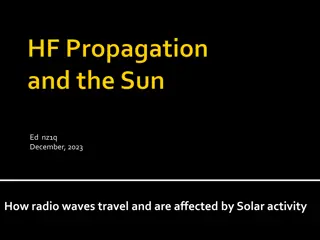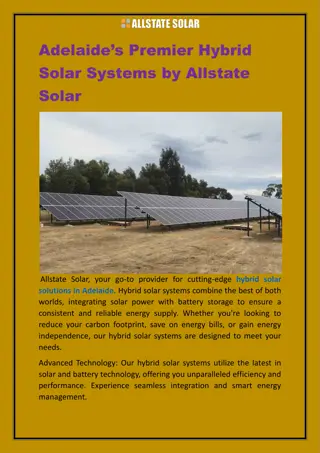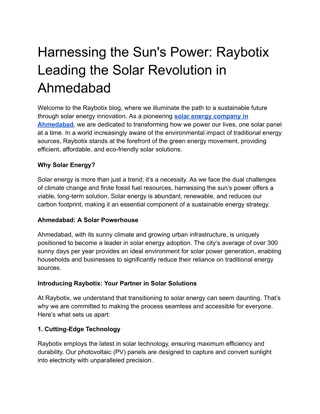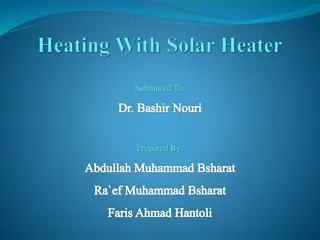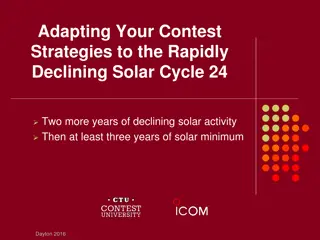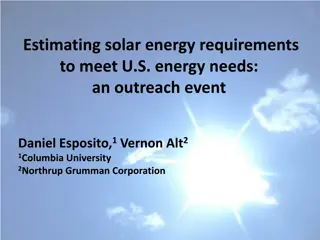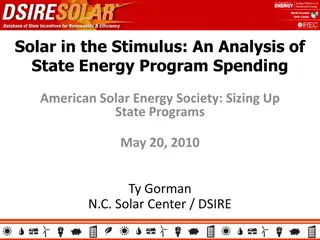
Green Chemistry and Solar Interaction
The slides explore the interaction of sunlight with matter, focusing on green chemistry and living in desert conditions. Topics include energy from the sun, sunlight effects, and light-matter interactions, discussing various types of light wavelengths and their impacts on matter. The content delves into what we want and don't want from the sun, highlighting the significance of sunlight in daily life.
Download Presentation

Please find below an Image/Link to download the presentation.
The content on the website is provided AS IS for your information and personal use only. It may not be sold, licensed, or shared on other websites without obtaining consent from the author. If you encounter any issues during the download, it is possible that the publisher has removed the file from their server.
You are allowed to download the files provided on this website for personal or commercial use, subject to the condition that they are used lawfully. All files are the property of their respective owners.
The content on the website is provided AS IS for your information and personal use only. It may not be sold, licensed, or shared on other websites without obtaining consent from the author.
E N D
Presentation Transcript
These slides contain animations, when the PowerPoint file is played The content gradually appears with clicks Questions appear before their answers
Green Chemistry and Living in the Desert Sun What we do and don t want from it Energy from the sun (fossil fuels vs renewables) Light/matter interactions Infrared, heat, greenhouse effect Ultraviolet, sunburn, sunscreen, oxygen, ozone layer
Green Chemistry and Living in the Desert Sun What do we want from the sun? Light to see Light for plants to grow Energy to power things Warmth (in winter) What don t we want from it? Sun damage Sun burn Too much heat (summer) Sun in eyes while driving? These processes result from the different ways that sunlight interacts with matter
Green Chemistry and Living in the Desert Sun Did you know?/have you noticed: You can sit in the sun behind a window and feel just as hot as if the window was not there, yet not get sunburned On a somewhat cloudy day you can feel relief from the heat of the sun, yet you can still easily be sunburned What is going on in those situations?
Light Matter Interactions Considering light as a wave, we can classify light by its wavelength: higher energy But this is just what we can see!
Light Matter Interactions There is a whole range light types at both higher and lower wavelengths: higher energy http://www.astro.virginia.edu/~rsl4v/PSC/light.html
Light Matter Interactions What effects does each type (wavelength) of light have on matter?: a) X-rays c) Visible light e) Microwaves b) Ultraviolet radiation d) Infra red light f) Radiowaves http://www.astro.virginia.edu/~rsl4v/PSC/light.html
Light Matter Interactions a) X-rays b) Ultraviolet radiation Promotion of electrons from low-lying atomic orbitals Promotion of electrons from molecular orbitals to higher energy molecular orbitals c) Visible light Same as UV d) Infrared light Excites bond vibrations in molecules e) Microwaves Excite rotations in molecules Excite nuclear spins in atoms f) Radiowaves http://www.astro.virginia.edu/~rsl4v/PSC/light.html
Light Matter Interactions When we heat matter the atoms and molecules vibrate faster IR light absorption causes atoms to vibrate within molecules As a consequence, absorbing IR light causes heating When we feel heat from the sun s rays, we are feeling the IR radiation Importantly, it is the ultraviolet radiation that causes skin damage and sunburn, not the heat from the sun (IR)
Light Matter Interactions Feeling hot from the sun and getting sunburned have different causes The earlier examples highlight this: You can sit in the sun behind a window and feel just as hot as if the window was not there, yet not get sunburned Glass absorbs the UV radiation that causes sunburn yet allows longer wavelengths (visible and some IR wavelengths) to pass. So, we still feel plenty hot due to the IR radiation. On a somewhat cloudy day you can feel relief from the heat of the sun, yet you can still easily be sunburned Clouds (water) absorb and scatter IR radiation more effectively than they do UV. So, we may feel cooler because less IR is striking us, however the penetrating UV can still easily cause sunburn.
Light from the Sun Sunlight energy reaching the earth s surface: 3-5% 42-43% Visible 52-55% Infrared Ultraviolet Wikipedia Sunlight
Light Matter Interactions You have probably heard of IR imaging: Absorbing IR light causes heating Similarly, in the reverse process warm objects emit IR radiation Hotter objects emit more IR energy than colder ones
Light Matter Interactions a) X-rays b) Ultraviolet radiation Promotion of electrons from low-lying atomic orbitals Promotion of electrons from molecular orbitals to higher energy molecular orbitals c) Visible light Same as UV d) Infrared light Excites bond vibrations in molecules e) Microwaves Excites bond rotations in molecules Excites nuclear spins in atoms f) Radiowaves
IR Absorption The energy of the IR light absorbed corresponds to the stretching and bending of chemical bonds Stretching Just as if the bond between the atoms acts like a spring: The frequency of IR radiation is in the same range as the rate of oscillation of the spring It s a little more complicated for molecules with more than 2 atoms
Light Matter Interactions Water and carbon dioxide molecules provide good examples for what happens when IR light is absorbed Water Carbon Dioxide Why are these particular compound s interactions with IR radiation very important? The Greenhouse Effect https://link.springer.com/chapter/10.1007/978-3-031-08834-6_4
Global Warming How are the ideas of the greenhouse effect, global warming, and climate change related? Related to pollution, what do we usually hear about as being the cause of this problem?
Global Warming Wikipedia Scientific consensus on climate change
Global Warming Everybody knows! In 1917 Alexander Graham Bell wrote "[The unchecked burning of fossil fuels] would have a sort of greenhouse effect", and "The net result is the greenhouse becomes a sort of hot- house."[ - Wikipedia
Green House Effect What is it? When heat energy is radiated from the earth s surface, molecules in the atmosphere absorb some of that radiation, effectively leading to a retention of the heat
Green House Effect http://bouw-markt.com/wp-content/uploads/2016/03/Bespoke-Greenhouse-8.jpg A real greenhouse works because the air that is heated inside is trapped by the structure.
Carbon Dioxide What does this graph tell us? Pretty compelling that with more CO2 the temperature is higher!
Atmosphere Composition We know that CO2 is the gas that everyone talks about when discussing global warming. But how much of it is there in the air? What is the air made of? N2 O2 Ar H2O 78% 21% 1% ~1% (varies) So, where s the CO2?
Atmosphere Composition There s not much CO2 in the air (about 0.04%), but that amount has a large effect Importantly, the atmosphere s two major gases N2 and O2 do not absorb IR radiation.
Green House Effect The earth s average surface temperature is about 14 C (57 F) What would you expect the earth s surface temperature to be under the following circumstances?: a) No atmosphere b) 100% oxygen atmosphere c) Air with 5% CO2 atmosphere d) 100% CO2 atmosphere
Green House Gases The major contributor to the green house effect on earth is actually water Percentage contribution (the major contributors) to the greenhouse effect: Water vapor 36-70% Carbon dioxide 9-26% Methane 4-9% Ozone 3-7% ~ 1.000000% ~ 0.042000% ~ 0.000170% ~ 0.000007% But what are the percentages of these in the air?
Green House Gases Percentage of the atmosphere Contribution to greenhouse effect Water vapor 36-70% Carbon dioxide 9-26% Methane 4-9% Ozone 3-7% ~ 1.000000% ~ 0.037000% ~ 0.000170% ~ 0.000007% Clearly, the gases do not influence the greenhouse effect with the same efficiency Another factor that must be considered is how long the gases persist in the atmosphere Global Warming Potential is a number that factors all of these into consideration.
Some Other Greenhouse Gases https://en.wikipedia.org/wiki/Greenhouse_gas
Carbon Dioxide Where is all this CO2 coming from? The combustion of hydrocarbon fuels: CxHy + O2 -> x CO2 + 2y H2O + Energy Where are those from? Mostly from: Natural Gas Petroleum Coal The fossil fuels





